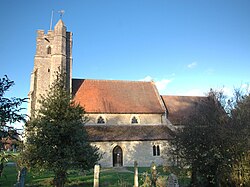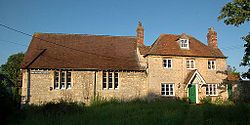Stanton St John
| Stanton St. John | |
| Oxfordshire | |
|---|---|
 St. John the Baptist, Stanton St John | |
| Location | |
| Grid reference: | SP577093 |
| Location: | 51°46’49"N, 1°9’51"W |
| Data | |
| Population: | 430 (2011) |
| Post town: | Oxford |
| Postcode: | OX33 |
| Dialling code: | 01865 |
| Local Government | |
| Council: | South Oxfordshire |
| Parliamentary constituency: |
Henley |
| Website: | Stanton St. John |
Stanton St John is a village in Oxfordshire about four and a half miles north-east of the centre of Oxford, standing on the eastern brow of a group of hills north-east of the city, in a slight saddle between two of the hills.
History
The course of the former Roman road that linked Dorchester on Thames with Alchester passes through the western part of the parish. In 1953 excavations up to 300 yards east of the parish church found evidence of Roman occupation.[1]
The Domesday Book records that in 1086 the manor was held by Odo of Bayeux, William the Conqueror's half-brother, and Ilbert de Lacy was his principal tenant.[1] De Lacy also held the manor in the adjacent parish of Forest Hill, but in about 1100 de Lacy's son forfeited both manors. After 1526 the manor of the village was granted to New College, Oxford.[1]
The village retains several 16th and 17th stone-built houses, including Manor Farm and the birthplace of John White,[2] a Puritan minister who was instrumental in founding the New England colony of Massachusetts.[1] A later John White ran Manor Farm on behalf of New College, and repaired the Manor Farm house in 1660.[1]
During the Civil War, Royalist troops were stationed in the village in 1643 and 1644 as part of the defence of Oxford against Parliamentarian forces to the east. In 1646 Parliamentarian troops occupied the village during the siege of Oxford.[1]
By 1706 a number of common fields had been inclosed, but more than 400 acres of common land remained to be enclosed by a private Inclosure Act in 1777.[1]
In 1717 Dame Elizabeth Holford left a bequest to be invested until it was large enough to endow a free school for the parish. Trustees to set up the school were appointed in 1759[1] and it started teaching in the vicarage in 1764.[3] A school was built on land provided by New College and completed in 1767.[1] The school closed in 1984 and became the Holford Centre in 1989,[3] a village hall.[3]
Parish church
The Church of England parish church, St John the Baptist was built in the 12th century. The arcade between the nave and north aisle dates from this period[1] and is in the Transitional style between Norman architecture and Early Gothic.[2] The chancel arch is also Transitional, but may have been rebuilt in about 1700.[1] The chancel was rebuilt around the beginning of the 14th century and is a high quality example of the transition from Early English (its side windows) to the Decorated Gothic (its east window, which has unusual tracery). The south aisle was built late in the 14th century, with a clerestory above its arcade to light the nave.[1]
In the 15th century all but one of the windows in the north aisle were replaced with Perpendicular Gothic ones and the bell tower was built.[1] The church furniture includes four early 16th century benches whose bench ends have unusual carvings of poppyheads, human heads and grotesque animals.
In fiction
Stanton St. John and its surrounding area are the setting for Gladys Mitchell's detective novel 'Dead Men's Morris',[4] featuring her series detective Dame Beatrice Adela Lestrange Bradley. Many real locations are mentioned, including Stanton Great Wood, the church and the nearby Forest Hill and Shotover Hill. Pig-rearing plays an important part in the book, and piggeries can be found in the neighbourhood.
Outside links
| ("Wikimedia Commons" has material about Stanton St John) |
References
- ↑ 1.00 1.01 1.02 1.03 1.04 1.05 1.06 1.07 1.08 1.09 1.10 1.11 1.12 Lobel 1957, pp. 56–76.
- ↑ 2.0 2.1 Sherwood & Pevsner 1974, p. 784.
- ↑ 3.0 3.1 3.2 "Holford Centre". Stanton St. John. http://www.stantonstjohn.com/about/amenities-2/holford-centre/.
- ↑ Mitchell 1936.
- Gilmour, Nigel (2004). "The Mediæval Manor at Stanton St. John: A 700th Anniversary?". Oxoniensia (Oxfordshire Architectural and Historical Society) LXXV: 51–91. SSN 0308-5562.
- A History of the County of Oxford - Volume 5 pp 56-76: Parishes: Stanton St. John (Victoria County History)
- Nikolaus Pevsner: The Buildings of England: Oxfordshire, 1974 Penguin Books ISBN 978-0-300-09639-2
- Mitchell, Gladys (1936). Dead Men's Morris. London: Michael Joseph Ltd.

